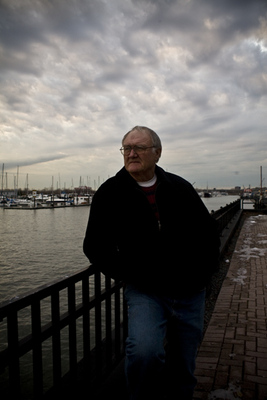BACK IN 1954, Tom Hanley, who now works as a crane operator at Global Marine, was throwing dead pigeons at Marlon Brando. The life of a longshoreman has changed a lot since a 14-year-old Hanley appeared with Brando in the classic Oscar-winning film On the Waterfront.
Hanley says he had a “good relation” with Brando. “I liked him. He was a great guy, a very down-to-earth kind of people guy. Most of the people in Hoboken will tell you that they met him and loved the guy.”
In those days, Hanley was living at 105 Hudson St. in Hoboken. “They first hired me to feed the pigeons,” Hanley says. “There were three coops, one on my roof and several along the row of houses where I lived. They filmed a lot of it on the roof of my building. I played the part of a little street kid who idolized the Brando character. There were a couple of kids in the movie but I was the only one who had a speaking role.” He got $500 for his work, which was a lot back in 1953.
“A longshoreman from New York was helping the movie company find places to shoot,” Hanley relates. “One day Elia Kazan [the director] and Budd Schulberg [the screenwriter] said that I was exactly what they were looking for. When Brando squeals on the mob, I get angry and kill his pigeons. I had a temper, and I was on the verge of juvenile delinquency.”
But he wasn’t an actor. “Elia Kazan was a very nurturing guy,” Hanley remembers, “even though I didn’t appreciate it at the time. He’d walk me through things, support me, tell me, ‘I know you can do this.’”
To prepare him for the scene, Kazan put him in a room with a cop Hanley hated. “We went at one another’s throat and then he put me out to do the scene. It was called method acting.”
HANLEY SAYS HIS FATHER who was a longshoreman in New York was murdered, and his mother worked at the Lipton Tea Factory, now the renovated Hudson Tea building where Governor Corzine lives. “We were starving to death,” Hanley says. “We were poor and had nothing. My mother had a heart condition and sometimes couldn’t work but was too proud to go on welfare.”
He went to high school for a year and then quit, working for a bookbinder on Fifth and Park in Hoboken. “Being a longshoreman was the next thing in front of me,” Hanley says. “All my relatives worked on the waterfront in New York and New Jersey. At that time if you had no education you drove a truck, went into construction, worked on the docks, or became a criminal.”
At 17, Hanley chose the docks. “I always loved the waterfront,” he says. “I was like in seventh heaven, hanging around with all the older neighborhood guys, my brother, and my uncles.”
WHEN HANLEY WAS WORKING the small finger piers in Hoboken, the longshoremen were going into the hulls of ships, slinging pallets, and hooking bags, and there were no containers. “We worked hard, played hard, and had great camaraderie,” Hanley says. “It was a feeling of family. It was hard physical work, and we worked under a lot of terroristic bosses, tough bosses, let’s put it that way.”
Times have changed. “It’s a million times different now,” he says. “The work is a lot easier, there’s no physical work. The only thing you have to fight is the cold. Bosses don’t have the power they used to have. In the old days you hadda work, you hadda make sure the job was done. You took pride in it.”
Now, he says, “a lot of the kids walk into a good deal, but they don’t know what they have, and they think they’re entitled to something. None of them went on strike. I’m the one who went on strike to get these benefits.”
But Hanley says that working with women longshoremen is “fine. In the old days they couldn’t work on the docks because of the physical labor and the abuse that went around.”
It would be hard to find a more perfect narrative of art imitating life than Tom Hanley’s.
“I’ve pretty well lived it,” he says.—KR
Our Digital Archive from 2000 – 2016
